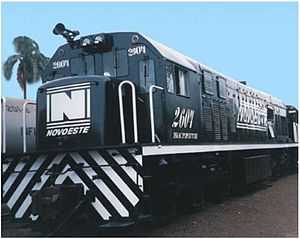GE U20C
| GE U20C | |
|---|---|
|
GE U20C from Novoeste railways, in Brazil. | |
| Type and origin | |
| Power type | Diesel-electric |
| Builder |
GE Transportation Systems GE Locomotive Indonesia |
| Model | U20C |
| Build date | 1995 – 2000 |
| Total produced | 42 |
| Specifications | |
| AAR wheel arr. | C-C |
| Gauge |
1,067 mm (3 ft 6 in) (1,000mm and 1,600mm), Brazil |
| Prime mover | GE FDL-8 |
| Cylinders | 8 |
The GE U20C diesel-electric locomotive was introduced by GE Transportation Systems as an export model road switcher in 1964. It was powered by the 8-cylinder FDL-8T engine. This locomotive is used worldwide with many variations and modifications. Different engines may be used, e.g. 7FDL8 and 7FDL12. Like the other members of the Universal series, it is compatible with all track gauges.
Indonesian U20C
A unique modification is the wide cab version of the 2000 HP U20C used on the 1,067 mm (3 ft 6 in) gauge Indonesian railroad and operated by PT Kereta Api Indonesia (Indonesian National Railway Company). Unlike other models of the U20C, with short hood cabin, the Indonesian U20C features a full-width cabin, for comfort and better sight of track and signals. It is classified as CC203 by PT Kereta Api Indonesia. The wide cab was built by Goninan Locomotive Work (now UGL Rail) in Australia.
Construction
Between 1995 and 2000, 41 units of this locomotive type were delivered to the Indonesia. Which numbered as CC203 01-41. The first batch is number 01-12 which that number were imported from GE Transportation in Erie, Pennsylvania, USA. And numbers 13-41 were built locally by GE Locomotive Indonesia, a joint company PT Industri Kereta Api Indonesia / Indonesian Railway Industry (PT INKA) and GE Transportation. Design of the CC 203 was designed between Goninan, Australia and GE, USA. Which Goninan construct the wide cabin and GE construct the engine and the body.
Operational
All locomotives are still in operation, and were allocated for pulling express passenger trains, but in special conditions they pull 3rd class and sometimes freight trains as well. All of CC 203 were painted with newest livery of Indonesian Railways Co.
Operational History
Actually CC 203 were build for commemorate 50 years of Indonesian Independence day in 1995. This locomotive specially build for pulling Argo express train like Argo Bromo JS950. After Indonesian Government launch many Argo Train, CC 203 always pull the Argo Train. After take at least 8 years, CC 203 not usually pulling Argo Train. Some train were pulled by CC 203. And now CC 203 will pull every train, not just passenger but freight train.
C20EMP
In year 2005, GE Locomotive Indonesia introduced a brand new locomotive with full computer control. It was given type as C20EMP and still uses the 7FDL-8 engine. The overall shape is similar to other Indonesian CC 203, but it has a Brightstar Sirius on-board computer to control the propulsion and transmission, for better fuel economy and lifetime. The power rating is 2150 HP but the power output is 1950 HP. Because the result is very good, PT Kereta Api Indonesia, made a contract with PT Industri Kereta Api Indonesia (PT INKA) to build 20's locomotives. Then, the brand-new C20EMP delivered from GE and assembled at PT Industri Kereta Api Indonesia (PT INKA). These C20EMP numbered as CC 204 08-xx and will be numbered as CC 204 12-17. CC204 08-09 delivered at 2008, CC204 10-11 delivered at 2009. A total of 30 locomotives were manufactured before the production ended in 2011. All CC204 are used for hauling coal trains and passenger trains in South Sumatra, replaced by CC206 (CM20EMP) in Java.
Export Version
In year 2000, PT Industri Kereta Api Indonesia (PT INKA) made the last CC 203 for Philippines Port Railways. It has same specification as Indonesian CC 203. But at after 7 years of revenue service, the container rail service was closed down. The locomotive was refurbished and was shipped to Australia for Coote Industrial Company. After strip down inspection and maintenance, the locomotive was put back on revenue service.
Gallery
-

GE U20C in Brazil, NOVOESTE #2625
-

GE U20C in Brazil, FERROBAN #3846
-

GE U20C in Brazil, FEPASA #3860
-
GE U20C Wide Cab in Indonesia, CC203 22
-
GE U20C, South African Class 33-000 no 33-009
See also
Further reading
- Prasetya, Amad; Sudarsih (May 2014). "Berburu CC 203 in Action". Indonesian Railways Magazine.
| ||||||||||||||||||||||||||||||||||||||||||


